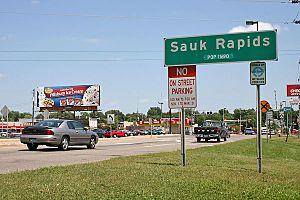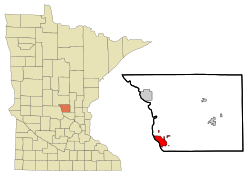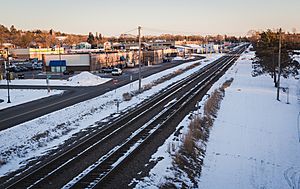Sauk Rapids, Minnesota facts for kids
Quick facts for kids
Sauk Rapids
|
|
|---|---|
 |
|

|
|
| Country | United States |
| State | Minnesota |
| County | Benton |
| Area | |
| • Total | 6.52 sq mi (16.89 km2) |
| • Land | 6.29 sq mi (16.28 km2) |
| • Water | 0.23 sq mi (0.61 km2) |
| Elevation | 1,033 ft (315 m) |
| Population
(2010)
|
|
| • Total | 12,773 |
| • Estimate
(2019)
|
14,146 |
| • Density | 2,249.68/sq mi (868.66/km2) |
| Time zone | UTC-6 (Central (CST)) |
| • Summer (DST) | UTC-5 (CDT) |
| ZIP code |
56379
|
| Area code(s) | 320 |
| FIPS code | 27-58684 |
| GNIS feature ID | 0651235 |
| Website | www.ci.sauk-rapids.mn.us |
Sauk Rapids is a city in Benton County, Minnesota, United States. The population was 12,773 at the 2010 census and is 14,146 according to 2019 census estimates, approximately one-third of the total Benton County population. It is located on a set of rapids on the Mississippi River near its confluence with the Sauk River.
Sauk Rapids is part of the St. Cloud metropolitan area.
History

Sauk Rapids was originally little more than a forest of oak, maple and basswood trees along the Mississippi River until the first home was constructed there in 1851, a large mansion named Lynden Terrace erected by W.H. Wood. Soon other settlers followed and the town was named Sauk Rapids after the rapids just below the Sauk River's mouth on the Mississippi. Soon a general store was built, then a hotel, and a large jail. The first settlers organized a Congregational church that was soon followed by a Methodist, an Episcopalian and a Lutheran church. The first paper outside of St. Paul was the "Sauk Rapids Frontiersman," founded in 1854.
A flour mill was erected in 1875, but was destroyed in 1886. In 1876, the first bridge was built, was destroyed later in 1876, but rebuilt in 1879. The first school was built in 1886.
In 1874, Sauk Rapids was the end of the line for the local railroad. All the settlers from as far away as the upper Red River Valley brought their produce there to ship it. A six-horse stage coach made bi-weekly trips between St. Cloud and Crow Wing.
In 1856, the county seat moved to Watab, then returned to Sauk Rapids in 1859. A new courthouse was built, but in 1897 the seat moved to Foley where it currently resides. In 1917 the courthouse burned down.
Sauk Rapids was one of the most important cities in Minnesota until 1886, when, on April 14 at approximately 4:00 p.m., a tornado struck the town. The twister swept through the heart of the city, destroying all of the stores. In Sauk Rapids alone, 44 people were killed and several hundred were wounded. The event was a great setback for the city, and though it has rebuilt since then it never regained its former prominence in statewide affairs.
In recent years, the downtown area of Sauk Rapids has gone through substantial changes due to the construction of the New Sauk Rapids Bridge. This was primarily because the new bridge links to 2nd Street rather than 1st Street, as the original Sauk Rapids Bridge did. Also the intersection of Benton Drive and 2nd street was adjusted so the new bridge would extend over the railroad tracks and land on Benton Drive. Several buildings had to be demolished during the construction process, which meant that some parts of downtown were rebuilt. In addition, some sidewalks were repaved with cobblestone and the medians were filled with granite blocks.
Geography
According to the United States Census Bureau, the city has a total area of 6.35 square miles (16.45 km2), of which 6.10 square miles (15.80 km2) is land and 0.25 square miles (0.65 km2) is water.
U.S. Highway 10 and Minnesota State Highway 15 are two of the main routes in Sauk Rapids. Other nearby routes include Interstate 94, Minnesota State Highway 23, and County Road 75. Sauk Rapids is immediately northeast of the city of St. Cloud, on the east bank of the Mississippi River.
Demographics
| Historical population | |||
|---|---|---|---|
| Census | Pop. | %± | |
| 1860 | 167 | — | |
| 1870 | 412 | 146.7% | |
| 1880 | 598 | 45.1% | |
| 1890 | 1,185 | 98.2% | |
| 1900 | 1,391 | 17.4% | |
| 1910 | 1,745 | 25.4% | |
| 1920 | 2,349 | 34.6% | |
| 1930 | 2,656 | 13.1% | |
| 1940 | 2,981 | 12.2% | |
| 1950 | 3,410 | 14.4% | |
| 1960 | 4,038 | 18.4% | |
| 1970 | 5,051 | 25.1% | |
| 1980 | 5,793 | 14.7% | |
| 1990 | 7,825 | 35.1% | |
| 2000 | 10,213 | 30.5% | |
| 2010 | 12,773 | 25.1% | |
| 2019 (est.) | 14,146 | 10.7% | |
| U.S. Decennial Census | |||
2010 census
As of the census of 2010, there were 12,773 people, 4,960 households, and 3,222 families residing in the city. The population density was 2,093.9 inhabitants per square mile (808.5/km2). There were 5,219 housing units at an average density of 855.6 per square mile (330.3/km2). The racial makeup of the city was 94.9% White, 1.2% African American, 0.5% Native American, 1.2% Asian, 0.4% from other races, and 1.8% from two or more races. Hispanic or Latino of any race were 1.8% of the population.
There were 4,960 households, of which 36.6% had children under the age of 18 living with them, 48.9% were married couples living together, 11.0% had a female householder with no husband present, 5.0% had a male householder with no wife present, and 35.0% were non-families. 26.8% of all households were made up of individuals, and 9.2% had someone living alone who was 65 years of age or older. The average household size was 2.49 and the average family size was 3.03.
The median age in the city was 32.8 years. 25.9% of residents were under the age of 18; 9.8% were between the ages of 18 and 24; 31.2% were from 25 to 44; 22.4% were from 45 to 64; and 10.8% were 65 years of age or older. The gender makeup of the city was 48.8% male and 51.2% female.
Education
Sauk Rapids has four public schools and one private. The schools include Mississippi Heights Elementary, Pleasantview Elementary, Sauk Rapids-Rice Middle School, Sauk Rapids-Rice High School, and Petra Lutheran School.
Notable people
- James Beatty, Minnesota pioneer and territorial legislator
- Lewis Mayo, Minnesota state senator, physician, and lawyer
- Rip Repulski, MLB All-Star baseball player
- Walter F. Rogosheske, Minnesota jurist and legislator
- Jeremiah Russell, pioneer and territorial legislator
See also
 In Spanish: Sauk Rapids (Minnesota) para niños
In Spanish: Sauk Rapids (Minnesota) para niños

